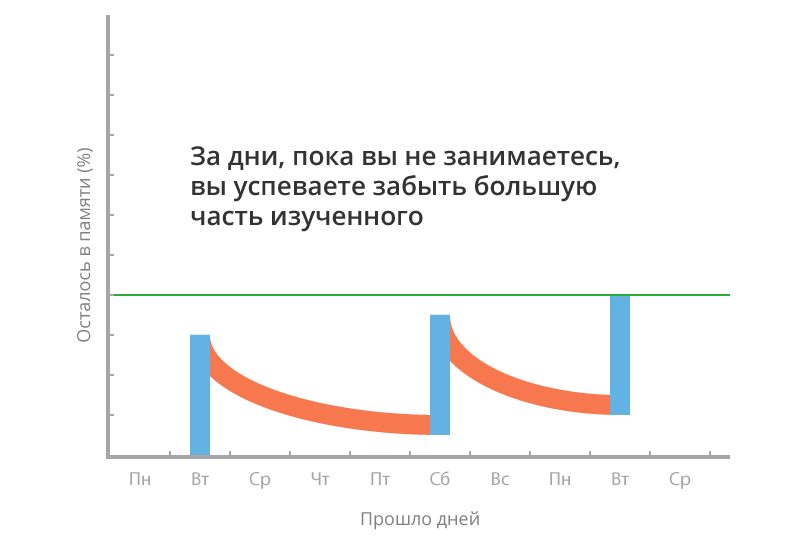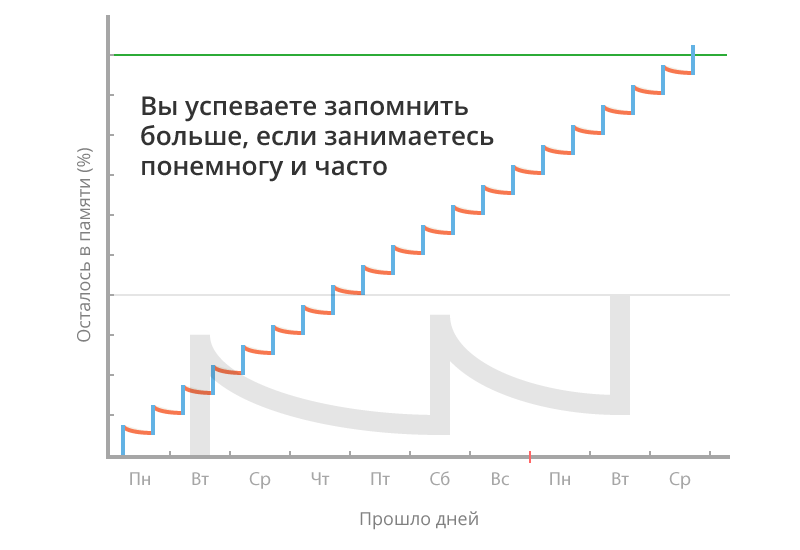Remember effectively: two important principles in language learning

In June, Arthur Dumchev, record holder of the Russian Book of Records for memorization, a recognized expert in the field of memory development, a trainer and consultant, joined the LinguaLeo team. Arthur remembers the number "Pi" to 22,528 decimal places and is the author of the book "Remember everything. A practical guide to developing memory . ”
Arthur is currently working at LinguaLeo to implement additional effective methods for memorizing words and phrases. We asked him to share tips on fast and high-quality language learning with readers of our blog, and Arthur talked about such hacks as “the reasonable use of mnemonics” and “systematics in learning”. So, what is it, and will it help in the development of memory and language learning? Let's figure it out.
Reasonable use of mnemonics
Mnemonics is a set of techniques that facilitate memorization. An example of the use of mnemonics: we need to memorize the word Shrug - "shrug." To do this, just imagine some visual image that will allow you to remember the word and its translation. For example, Shrek shrugs. When you hear Shrug, you will immediately remember this image, and then the translation of the word.
There are some good articles on mnemonics on Habré, where the basic principles are described in detail. Here they are: about mnemonics , one and twoabout mnemonics and language. Arthur used similar methods to remember the number of Pi. “After meeting with mnemonics, I tried to use it wherever possible. I tried to remember new routes, events from life, conversations and phrases, names and faces, lectures at the university and books. Of course, he also used mnemonics to study foreign languages - he learned to memorize up to 100 words per hour. But this does not mean at all that you can spend 40 hours and for 5-6 days remember 4000 words in high quality. ”
At memory championships, mnemonists will remember 300 or more foreign words per hour. Why don't they become polyglot? The fact is that on the day after the competition such an athlete-mnemonist, most likely, will not remember even 50 words out of 300 memorized. And those 50 that he still remembered, he will not be able to instantly recognize in speech.
If you want to translate a word into an active vocabulary, you need to meet it in the text a few dozen times, hear it a few dozen times in a speech and, most importantly, start using it yourself. This also applies to those words that you memorized with the help of mnemonics: as long as you do not use them in speech, they, at best, will lie in the passive reserve. When you start using them, they will be remembered directly, without images.
This raises the question of the appropriateness of using mnemonics. Why waste time inventing any images if, as a result, the necessary number of repetitions will still provide memorization? There are 2 points to consider:
FOR: Mnemonics makes it possible to memorize faster. You pick an image once - and from that moment the word goes into your passive vocabulary. Quickly remember a word without images or associations will not work.
CONS: Sometimes the selection of images takes too much time, and the images themselves do not make it easy to remember a word. Suppose you want to remember that conclusive translates to convincing. What images would you pick? Would you imagine how a horse speaks with cranberries very convincingly?
Conclusion: Mnemonics should be used when it's convenient. Consider two cases:
• If associations automatically fall into place, then, of course, the use of mnemonics will speed up memorization.
Examples:
pillar - pillar. Imagine you sawing a pillar.
broth - broth. Try to see how the brooch fell into the broth.
ledge - ledge, ledge. Imagine that you wanted to lie down and lay on a ledge.
• Words for which simple associations are not selected are best remembered through repetition.
Examples:
contemplate - contemplate, reflect,
contemporary - modern;
contempt - contempt;
condemn - condemn.
There are a lot of words beginning with “con”. If you use the image of a horse or canned food every time, you will soon begin to get confused. A possible option is to mentally choose a special building in which you will place images of only those words that begin with “con”, but this technique would be more suitable for speed memorization in competitions. In learning a language, this is an unnecessary and unnecessary step that simply takes extra time.
Systematics in training
It took Arthur about two months to memorize 22,528 digits of pi. Then, for about six months, he supported it in his memory, repeating a thousand numbers daily - it took 10-20 minutes, depending on the concentration of attention. Immediately before the record, Arthur actively (5-10 hours a day) repeated the number for another month.
Let's draw an analogy. Arthur used one image to memorize two digits. To remember one foreign word with a translation, he would need two images - for the word itself and for its translation. If two numbers are one image and two words are four images, then you can roughly equate 22 528 numbers to a vocabulary of 5632 words (22 528/4). That is, we can conditionally assume that if Arthur, instead of remembering the number Pi, was learning a new foreign language, then he would transfer more than 5 thousand words to his vocabulary. According to him, systematics plays an important role: no matter what happens, you need to give at least 10 minutes of repetition every day. Successful experience in learning languages, as a rule, is also associated with the need to study daily.
A couple of stories about polyglot
The famous archaeologist and entrepreneur Heinrich Schliemann was fluent in more than 10 languages. It took him 6 weeks to learn a new language, after which he could freely communicate with native speakers. Maybe the matter is in his natural abilities? It is likely, but it is impossible not to mention that when Schliemann took up the next language, he devoted almost all his free time to it. There is a good article that briefly describes the facts and conclusions from Schliemann's experience in learning languages.
Another famous polyglot, Kato Lomb, one of the first simultaneous interpreters in the world, studied languages through reading fiction. At the same time, she tried to understand the grammar rules on her own, after only checking with textbooks. The method is harsh: no video with subtitles, no interactive courses. Just an original book and a dictionary. How did she manage to learn more than 10 languages using this technique? The answer can be found in two quotes from her book “How I Learn Languages”:
“If someone is not able to donate an hour and a half a day for this, then by the proposed method (however, and in no other way) the desired result will reach. "
“Bitter experience, but it is necessary to declare it: the time spent on studying will be in vain if you do not reach a certain density of classes per week, and even better - per day.”
How to explain the need for daily classes?
Sisyphean labor
At the end of the 19th century, the German psychologist Herman Ebbinghaus, conducting experiments with memorizing meaningless syllables, revealed an interesting pattern: at first, forgetting is very fast, and then slows down.

Suppose you decide to study English on Tuesdays and Saturdays - 4 hours one lesson (only 8 hours a week). This is how it could be presented on the forgetting chart.

And it would look like 2 classes a day for 30 minutes each (only 7 hours a week)

The advantage of daily activities is that you repeat each specific word or language pattern more likely before you have time to forget it. At the same time, many, knowing that it is necessary to practice every day, continue to deceive themselves: “today I am busy, I will work out tomorrow or the day after tomorrow ...” What comes of this? You memorize words and rules, then forget them and you have to memorize them again, so it takes not 3-4 months, but several years to learn the language. It’s better to take the language seriously right away. To do this, you need to follow only two rules:
1. Allocate 30 minutes a day, which you completely devote to learning the language.
2. Do extra work during the day - for this you can use the time, which usually disappears in traffic jams, in lines, in the subway.
Get involved every day with LinguaLeo, have fun and result! Follow our news on Twitter , Facebook , vkontakte and Instagram .
